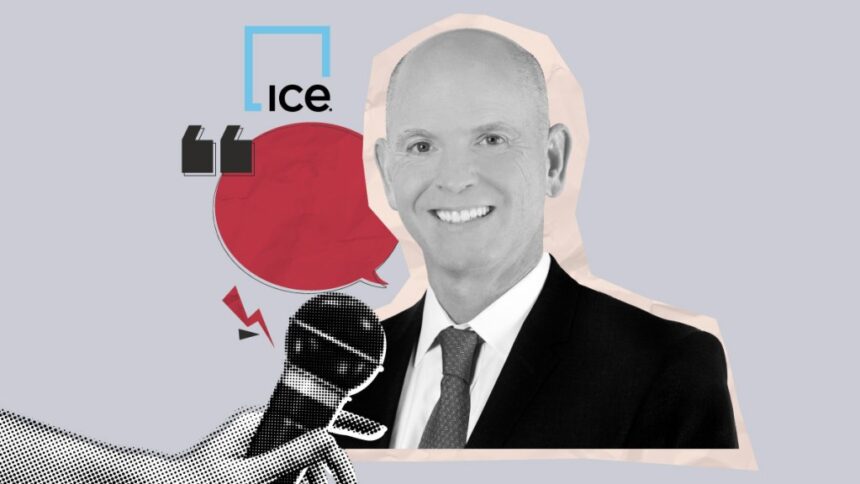
Tim Bowler, the president of ICE Mortgage Technology, appreciates a good analogy. The former Goldman Sachs managing director and U.S. Treasury official says that the mortgage technology giant’s integration of Black Knight isn’t dissimilar to building a rail line.
Much of the underlying technology that powers Encompass, ICE’s core originations technology, runs on, let’s say, a 2-meter track gauge. But MSP, the flagship servicing technology engine acquired in the $12 billion Black Knight deal, runs on 2.01-meter gauge.
“That created inefficiencies so that one couldn’t send trains across borders,” Bowler said in an interview with HousingWire in Las Vegas during the recent ICE Experience 2025 event.
“We want to basically have the same gauge width so that the file being manufactured in Encompass can go seamlessly into MSP without any issues whatsoever.”
The datasets from when loans were funded in Encompass should port over to MSP and appear exactly the same. The data must be easily accessible and constructed in a logical fashion that can prevent wasted human capital from having to reconstruct the past, Bowler said.
If 2024 was a year defined by setting the stage to integrate the two largest players in the mortgage technology space — which combined to have an estimated two-thirds market share — 2025 is about rolling up their sleeves and doing the hard (and expensive) work.
And if the past two years are an indication, ICE will invest billions more in 2025 to seamlessly integrate origination and servicing into one ecosystem, while modernizing some of its own software products like SureFire CRM. That’s occurring even in a slow mortgage market that hurts software-as-a-service (SaaS) providers, whose revenue is largely transaction-based.
This investment means there’s some red ink on the company’s balance sheet. According to Intercontinental Exchange‘s 10K, the mortgage technology segment delivered $2 billion in revenue in 2024, but its operating income loss totaled $170 million loss (an improvement on its $276 million loss in 2023).
ICE’s origination technology business generated $713 million in revenue last year, while its servicing software business made $848 million. Data and analytics generated $259 million, while closing solutions (which includes MERSCORP revenue) came to $202 million, SEC filings show.
There are about 13,000 workers in ICE’s mortgage technology segment, and expenses are rising. ICE will also have to navigate increased regulatory scrutiny resulting from the Ellie Mae and Black Knight acquisitions, and it must contend with less expensive rivals who are ambitious in their own right.
HousingWire spoke to Bowler about the efforts to modernize Encompass from legacy SDK technology, the technical work of connecting Encompass and MSP, company priorities and more. This interview has been edited for length and clarity.
James Kleimann: Could you provide an update on the efforts to fully transition to an API framework?
Tim Bowler: First and foremost, those that use SDK use it for a multitude of reasons. Nobody’s fully transitioned over. That notwithstanding, the move to APIs from SDK is massively accelerating because it’s being done in partnership with — no pun intended — our partners leveraging EPC, the Encompass Partner Connect.
And the benefits that our existing client base is seeing by migrating away from the old SDK — which put a latency tax on the system that was hardly noticeable when you’re only making a few loans — becomes very noticeable when you start making a few hundred or a thousand loans in a given month. It’s been really, really beneficial.
Around the completion of the work, we don’t know. I’ll tell you the exact same thing I told you over the summer which was, we set out a framework where the transition, ideally, we’re going to try to create some incentives to get that done by the fall of next year. Then we have a grace period of an extra six months before we start charging for calls, and then we have a very nominal, small fee. It’s tiny, but it’s more like the cultural push on ourselves to deliver the API framework.
Kleimann: I’ve heard some concerns about certain elements of SDK components not porting over — visuals in particular. Where are you in terms of porting that over?
Bowler: One of the blessings and the issues within Encompass is it was a very configurable piece of software. SDK lets you basically configure the visuals in a way that offers great flexibility.
It’s just once you started doing a few hundred loans or more, then it created a tax, because you were not only firing the system of record, but you were firing the software that supported the underlying SDK, and that created latency issues. So that is one of the bigger growing pains around, like, do you want to continue to have those tools?
And we’re going to have the flexibility to allow that, vis-a-vis to try to find a native way in Encompass to leverage some of that functionality that might have been designed through an SDK. And that’s where we’re trying to meet our clients in the middle. There’s some unique, bespoke work features that people have done within the context of their workflow management — whether it be around the transition from underwriting, the closing, some of that was SDK-related.
Kleimann: You mentioned latency. I’ve heard anecdotally that latency has improved. Is that true? What does that process look like?
Bowler: First and foremost, there’s just the low-hanging fruit of what data center you’re getting networked to. That’s common sense, very easy to execute on. We ran a process, tried to be certain that we were optimizing what data center was being called, when and how, within the context of a cloud-based usage for Encompass.
Secondly, it really is partnering with your clients and optimizing the workflows. Why are you firing that rule at this point in time? Why are you firing that call at this point in time? Why are you doing that segment of your population in Encompass, when they can work outside of Encompass and repopulate that into the system of record? Why are you using Encompass as a database for loans that were stale, that never got closed, but you just kept them in Encompass, as opposed to in cold storage, which was impacting your latency?
We went through a whole process with our existing client base around that, and just chipped away at some of the inefficiencies on that and how they were using Encompass, because nobody had come in and done a health check with them.
Kleimann: Acquiring Black Knight is a massive undertaking. How is ICE prioritizing this work?
Bowler: Let me try to break that into two pieces, because I know exactly what our clients told us they want to see. No. 1, and I’ll use a railroad analogy, they want Encompass and MSP to basically be operating on the same gauge width. Because in the past, Encompass and MSP were just operating with different gauge bits on the track.
You’re putting the datasets, once the loan is funded, onto MSP as a servicing system of record that matches exactly what the core datasets were that were used to underwrite that loan. And then those documents that need to be evidence within the context of that underwriting activity, they’re organized in such a way that they’re easily accessible by the service. And within the context they would need to be audited for whatever reason, that’s done in a logical fashion that can prevent lots of wasted human capital having to reconstruct the past. That’s critical to us.
Second, we want to be able to send the train back on those rails. Within the context of somebody that wants to refinance their loan that’s being serviced by a servicer on MSP, they can easily recreate the file for that loan to be refinanced as fast as possible, to allow the household to start saving money quicker.
For that matter, if you want to add a home equity loan or some other type of financing associated with the property, we can leverage the dataset that already rests in MSP to pre-populate that application. So that’s bucket No. 1 in clear priority.
The second bucket is for other services that are just 100% necessary within the mortgage ecosystem in which there’s just numerous providers out there that we want to offer our clients. If they use MSP, if they use Encompass, just giving them the capacity to have a dynamic choice.
It’s very much about improving what we call our customer acquisition suites — thinking about CRMs, household engagement tools, product and pricing engines. How can we give them a native product and pricing engine in Encompass that might give them value within the context of how they’re leveraging the system? Let’s make it easier for a lien release or to pay off what’s to be executed. Clients want us to improve those core aspects of the mortgage manufacturing or servicing process that dock into the system of record.
Kleimann: Could you talk a little more about the integration between Encompass and MSP? I would think there’s an opportunity to bring on clients who were on one but not the other.
Bowler: There’s a lot of customers on MSP and there’s a lot of customers on Encompass that aren’t on the systems of record — and vice versa. That universal rail that works between their system of record and origination, and that system of record and servicing being united, is a huge benefit for them for a number of reasons. First and foremost, I think they can drive costs out of their system by not having the inefficiencies of boarding alone or reboarding.
Second, it’s easier to train your staff on one core system and one core code base. And third — and this is near and dear to my heart, having lived through the great financial crisis — the ability to control your data and documents in a much more controlled fashion really reduces a lot of your compliance risk.
What historically happened in the past is, a loan would be originated and it would be sold. It would then get boarded into a servicer. Something would get missed in that process and bad data would get into the system. That bad data would then corrupt how that household was serviced down the road.
Something bad would go wrong, it would get audited. There would be a repurchase claim and an engagement with the regulator. That was unpleasant. We’re trying to avoid all that by having an integrated system where the documents and data can be much more dynamically and efficiently managed.
Kleimann: What could ICE do better?
Bowler: I keep pushing our team to expand their expertise on how our clients are either manufacturing loans or servicing loans, to really try to put themselves in their shoes on how to improve their workflow.
I think there was just always so much temptation in the software space to think that you can go up to the mountain, dream up a better way of doing this, bring it down to the masses and say, ‘I’m the Steve Jobs of the mortgage tech business because I dreamed up a better way of engaging.’ And I just don’t think that’s the way it works.
Actually manufacturing a mortgage to investor and insurer standards, or servicing a mortgage to investor, insurer and regulatory standards, is very much a human activity to a great degree. There’s a lot of human capital that’s involved with it. And we know need to help our clients figure out how our software can help them optimize that human capital to produce the best outcome for them as businesses,
Equally, if not more important, they need to produce the best outcome for the households that they’re serving. So that’s what keeps me up at night — and that’s why I don’t sleep so well.







